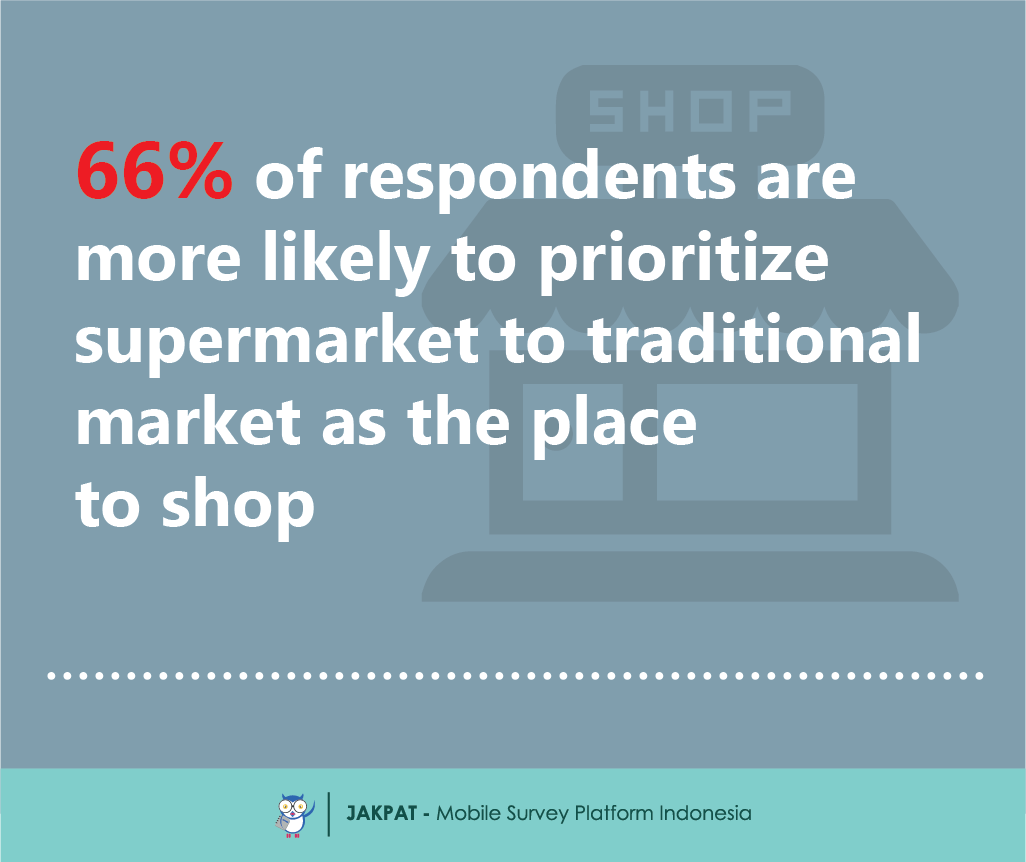Who do not love shopping? We guess most people love shopping although in some cases shopping seems like a guilty pleasure. Be it window shopping, or even just shopping for daily needs, we may acknowledge that we love to do it. Previously, we have conducted a survey toward millennials mom about their cooking habit and we discovered that there was something unique about their shopping habit. Different segment of millennials mom have different habit on their shopping frequency and preferred market. Some of them tend to prefer supermarket, while some others prefer traditional market. Understanding this insight, we would like to do further discovery about Indonesian preferences between traditional and supermarket as their preferred destination of shopping. We conducted this survey by expanding our panel of respondent, as it was not only specifically subjected to female, but also male. We considered that shopping in both markets could be done by both gender and we expected to capture bigger insight. 194 respondents from nationwide were participated in the survey. Random sampling was used as the sampling method with only 5% of margin error and 95% confidence level.
First of all, we found interesting finding about Indonesian customers’ preferences of market destination and their preferred shopping products. Customers were more likely to buy toiletries and ready to eat food products in supermarket. In other hand, they were more likely to buy food materials in traditional market.
We further asked them about their specific products they bought both in supermarket and traditional market. Four answers were mentioned by respondents such as toiletries, dairy products, frozen food, and snack.
Although food seems to be the product they loved to buy in supermarket, they also love to buy different kind of foods in traditional market. They said that they were more likely to buy fruit and veggies in traditional market. Following the answer, they also said that they bought egg and meat, seasoning, rice, and traditional snack.
Regarding their frequency of shopping, Indonesian customers said that they do not have regular pattern on shopping both in traditional and supermarket. According to our findings, their frequency of shopping was quite varying.
As the absence of specific habit on their shopping frequency, we would like to explore the variances. Interestingly, there were different pattern of frequency on both markets. In traditional market, customers tend to go there every day, only on weekend, and only on weekdays. Some of them even said that they never go to traditional market. In other hand, they were more likely to occasionally go to supermarket. Half of them said that they were more likely to go to supermarket once a month. Some others also said that they go to supermarket only on weekend, only when promotions available, and only on weekdays.
We then asked our respondents to mention their favourite supermarket to shop. Four famous supermarkets were mentioned such as Carrefour, Hypermart, Giant, and Super Indo.
The further step to compare supermarket and traditional market has been done by asking respondents to prioritize their first destination to shop. Interestingly, although in previous finding we found that respondent tend to occasionally shop in supermarket, they consider to put supermarket on the first place to shop. More than half of respondents said that they were more likely to prioritize supermarket than to traditional market as the place to shop.
For the finding were interesting, we further asked them about their reason of prioritizing. We discovered that two different segments of respondent have different motives. Respondent in the age of 18-25 years old said that supermarket were chosen as the first destination due to their comfort, cleanliness, and longer operational hours. Different motives also found among respondents in the age of 26-35 years old that said their motives were based on the consideration that supermarket tend to offer various promotions, the locations were near, also the comfort and cleanliness.
Although there were less respondent who prioritized traditional market, we still wanted to understand their reason of prioritizing. Respondent in the age of 18-25 years old said that their reasons were based on the economic and cognitive aspects. They considered that the sellers in traditional market have better knowledge of product quality and the price was cheaper. In other hand, respondent in the age of 26-35 years old said that their reasons were based on the geographical and economic motives. They prioritized traditional market because the locations were near and there were a chance to bargain.
At last, we would like to discover about their negative perceptions about both markets. Traditional market were negatively perceived as dirty, less safe, less variation of products, and only open at certain times. Other while, supermarket was negatively perceived as expensive, less fresh products, and required respondent to queue for paying. If only both traditional and supermarket could understand the insights, have the willingness to upgrade their services, and fulfil customers’ expectations then we surely believe that customers would be happier to shop there.
For more detail you can download XLS report at the button below (bahasa). JAKPAT report consists of 3 parts which are 1) Respondent Profile, 2) Crosstabulation for each question and 3) Raw Data. Respondent profile shows you demographic profiles ( gender,age range, location by province, and monthly spending). Cross tabulation enables you to define different demographicsegment preference on each answer.
Result in Bahasa
You can also download PDF here:
















